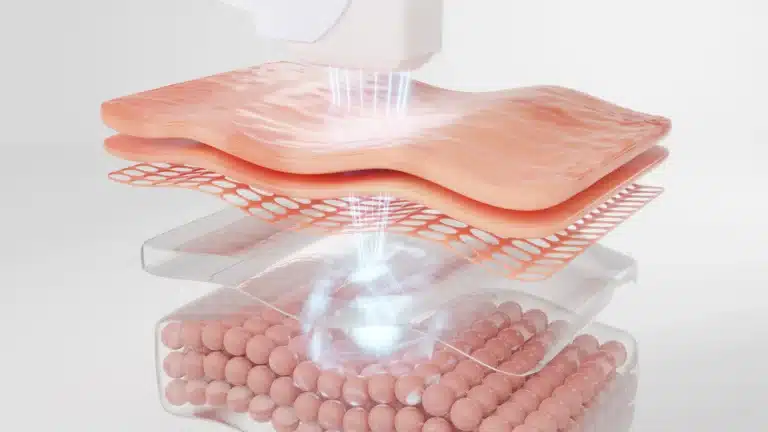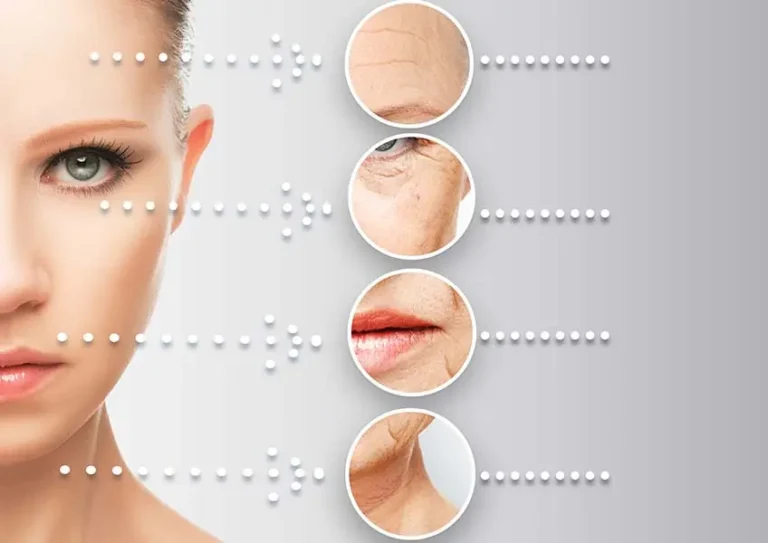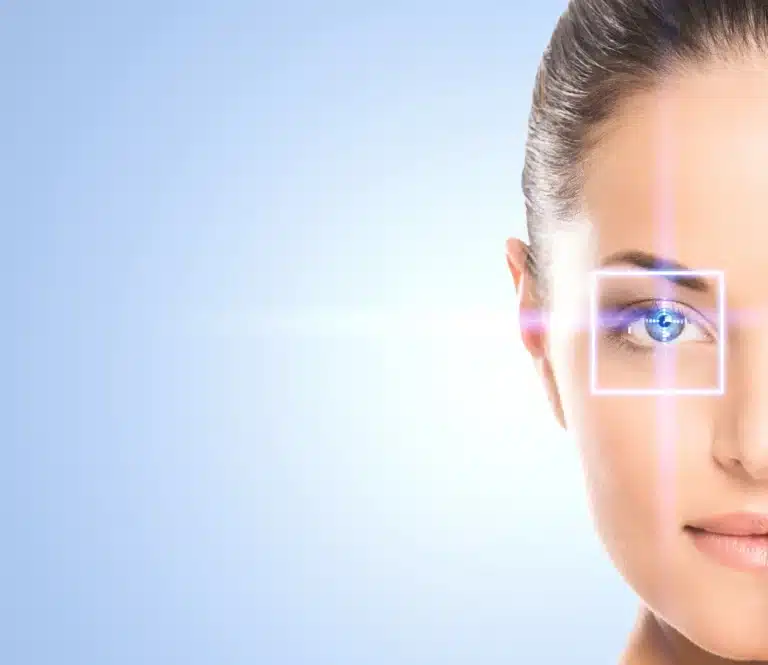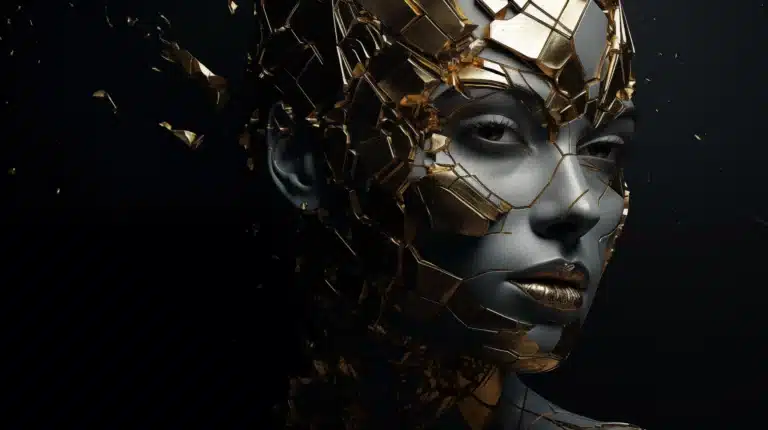Home » Solutions » Lasers and devices » Ablative laser
Ablative lasers are lasers that vaporize part of the skin in order to remove pigmentation or stimulate collagen production.
There are two types :
The Erbium Glass laser is not an ablative laser — its action is purely thermal.
Two treatment modalities are used :
Continuous mode : the entire surface is treated.
Fractional mode : a percentage of the area is vaporized in the form of microscopic columns. This is the most commonly used mode because the after-effects are lighter.
What is a fractional laser ? Fractional lasers, such as the Fraxel laser or the CO2 laser, use beams of light to remove the superficial layers of the skin. This process stimulates collagen production.
These devices are used to treat wrinkles, fine lines, dark spots, signs of skin aging, scars — particularly acne scars — and stretch marks. This anti-aging treatment, widely used, is a skin resurfacing and wrinkle-smoothing method.

The laser mechanism of action is twofold :
It is very important to consult an experienced doctor because the treatment is tailor-made : the goal is to obtain the best result while avoiding side effects.
The difficulty lies in the settings. Several parameters must be configured: the energy delivered, the spot size, the percentage of spot overlap, pulse duration, and frequency.
This complexity explains the differences in results (and side effects) obtained by practitioners.

To reduce wrinkles, several types of lasers can be used, each with its own advantages depending on wrinkle depth, indication, and skin type.
The choice of laser will depend on several factors.
Dr. Romano will recommend the treatment best suited to your needs and explain the benefits and drawbacks of each option. A personalized treatment plan will ensure the best results.
Fraxel Dual Laser
How it works : this laser uses fractional technology to create micro-thermal damage in the skin, stimulating collagen production.
Advantages : effective for fine to moderate wrinkles, it also improves skin texture and reduces pigmentation. Downtime is relatively short.
Idéal pour : les patients qui cherchent une amélioration globale de la texture et de la fermeté de la peau avec un temps d’arrêt minimal.
Fractional CO2 Laser
How it works : this laser emits light beams that deeply penetrate the skin, vaporizing damaged superficial layers and strongly stimulating collagen production.
Advantages : highly effective for deep wrinkles and scars. It provides spectacular results in terms of skin rejuvenation.
Idéal pour : les patients ayant des rides profondes et qui acceptent un temps de récupération plus long (jusqu’à deux semaines).
Erbium YAG laser
How it works : this laser removes the skin’s superficial layers more gently than the CO2 laser, with less thermal damage.
Advantages : effective for fine to moderate wrinkles and superficial imperfections. The risk of post-inflammatory pigmentation and scarring is low.
Idéal pour : les patients ayant des rides modérées, des cicatrices d’acné, des vergetures, les patients à la peau mate.
Nd-Yag laser
How it works : the laser beam penetrates deeply into the skin, heating underlying tissues to stimulate collagen production without damaging the skin’s surface.
Avantages : non ablatif, donc sans temps de récupération. Peut être utilisé en complément d’autres traitements pour en améliorer les résultats.
Idéal pour : les patients ayant des rides légères et à la recherche d’un traitement sans éviction sociale.

Le respect des contre-indications est essentiel pour garantir la sécurité et l’efficacité du traitement. Les contre-indications sont :
The fractional ablative laser is used to treat various areas of the face and body.
In Geneva, Dr. Romano uses the fractional laser for several indications.
Le laser ablatif fractionné est une méthode extrêmement efficace pour réduire les rides. Ce type de laser, en enlevant des micro puits de peau, stimule les cellules de la peau à produire du collagène et de l’élastine, les protéines essentielles à la fermeté et à l’élasticité cutanée. C’est via ce mécanisme que le laser ablatif fractionné lisse rides et ridules, améliore la texture de la peau et lui donne une apparence plus jeune et revitalisée. Les résultats sont visibles après une seule séance, bien que plusieurs traitements puissent être nécessaires pour obtenir des résultats optimaux.
Fractional ablative laser is designed to improve the skin safely and in a controlled manner, but like any medical procedure, it can cause temporary side effects. After the treatment, it is normal to observe redness, swelling, and peeling. These reactions are signs of healing and skin regeneration.
The skin will not be damaged. The risk of scarring or permanent damage is very low when the treatment is performed by a qualified and experienced professional.
It is essential to follow your doctor’s post-treatment care instructions to avoid any side effects.

La séance laser est précédée d’une consultation où le docteur Romano s’assure qu’il n’y a pas de contre-indications et que le patient est un bon candidat pour le traitement.
A numbing cream is applied one hour before the session. The eyes are protected with goggles. The settings are selected based on skin type and the desired result. The fractional laser session lasts approximately twenty minutes.
Le traitement n’est pas douloureux. Le patient ressent une sensation de chaleur et de picotement pendant la séance. Une crème anesthésiante est souvent appliquée sur la zone à traiter une heure avant la séance.
Before the session
After the session

The main side effects are :

Fractional ablative laser is a cutting-edge technique in aesthetic medicine; the results are remarkable and appear quite quickly. They are visible 3 to 8 weeks after the session and optimal 3 to 6 months post-treatment.
Les effets bénéfiques du laser ablatif fractionné, tels que l’amélioration de la texture de la peau et la réduction des rides, peuvent durer plusieurs années. Une séance d’entretien annuelle est conseillée.
For scars and stretch marks, the results are permanent; however, one maintenance session every five years is advised.
During the initial consultation, Dr. Romano will examine your skin, discuss your expectations, propose a treatment plan tailored to your needs, and inform you of the number of sessions required.
The number of sessions needed for optimal results depends on :

Fractional ablative laser and fractional radiofrequency fractionnée sont deux technologies de médecine esthétique qui ont des mécanismes d’action différents et donnent des résultats différents.
Le laser ablatif fractionné utilise des faisceaux de lumière pour créer des micro-perforations dans la peau, stimulant ainsi la production de collagène et favorisant une régénération rapide des tissus cutanés. Cette technique est particulièrement efficace pour traiter les rides profondes, les cicatrices d’acné et les irrégularités de texture. Les résultats sont visibles après une seule séance, le temps de récupération est relativement court.
La radiofréquence fractionnée utilise des ondes électromagnétiques pour chauffer les couches profondes de la peau sans endommager la surface. Cette chaleur stimule la production de collagène et d’élastine, entraînant un raffermissement de la peau et une réduction des rides et des ridules. Cette méthode est souvent proposée aux patients qui cherchent une solution non ablative avec un temps de récupération minimal. Elle est particulièrement efficace pour le raffermissement de la peau et le traitement des peaux plus foncées.
The choice between fractional ablative laser and fractional radiofrequency depends on the patient’s specific needs and treatment goals. Fractional ablative laser is ideal for significant improvements after a single session, whereas fractional radiofrequency requires multiple sessions.
The price of an ablative laser session in Geneva is approximately 900 CHF. This rate varies depending on several factors, including the surface area to be treated, the type of laser used (fractional CO₂, Erbium, etc.), and the complexity of the indication (deep wrinkles, scars, extensive skin resurfacing). A full protocol may include multiple sessions spaced 2 to 3 months apart.
The cost of an ablative laser treatment always includes thorough medical supervision, a prior dermatological evaluation, the use of a state-of-the-art medical laser, and post-procedure follow-up. It is not merely a technical procedure, but a dermatological intervention requiring expertise, personalized technique, and optimal safety.
An initial consultation is essential to establish a suitable treatment plan and an accurate quote, based on the specific needs of each patient.
Many patients report a significant improvement in skin texture and quality after just a few sessions, with a visible reduction in wrinkles, acne scars, and pigmentation. Patients also appreciate the long-lasting results.
Doctors praise this technology for its precision and effectiveness; the device allows for targeted treatment of specific areas while preserving the surrounding tissues. Feedback indicates that, although the recovery period can be uncomfortable, the results are well worth it.
However, it is essential to choose a qualified professional to perform the treatment in order to achieve optimal results and avoid complications.
Fractional ablative CO2 and erbium lasers are considered to be the best lasers for treating scars, particularly acne scars. They specifically target the damaged areas while preserving the surrounding tissue. The results are long-lasting and visible.
It all depends on the type of unsightliness to be treated and the desired results.
The effects of Fraxel treatment can last from several months to several years, depending on the type of skin and the problem being treated.
Maintenance sessions may be necessary to maintain long-term results.
Yes, there is a period of social avoidance after a fractional ablative laser session; it takes between 5 and 7 days for the skin to heal sufficiently to resume normal social activities without discomfort.
After treatment with Fraxel, the skin may be red and slightly swollen, like after a sunburn. This redness may last for a few days, after which the skin begins to peel. You may also feel a warm or tingling sensation during the healing period.
Yes, laser treatment can be very beneficial for the face. It is used to treat a variety of skin problems: wrinkles, age spots, acne scars and textural irregularities. However, it is essential to consult an experienced doctor to determine the most appropriate type of laser and to achieve visible results without side effects.
Yes, the ablative laser is very effective in treating acne scars.
The Fraxel laser creates tiny columns of thermal micro-damage in the skin. This stimulates collagen production and cell regeneration.
Fraxel laser treatment may be slightly painful. The sensation felt is often described as a sort of tingling or slight burning sensation. To minimise discomfort, an anaesthetic cream is usually applied to the area to be treated before the session. After the treatment, the skin may remain sensitive and red for a few days.
Recovery time depends on the intensity of the parameters used and the type of skin. In general, it takes between one and two weeks for the skin to heal completely. During this period, the skin may peel and fine scabs may appear.
The ablative laser is effective in treating various skin problems.
The fractional CO2 laser and fractional erbium laser are ideal for gentle facial rejuvenation. The continuous CO2 laser and the continuous erbium laser are indicated for more extensive rejuvenation.
Because it's an effective, fast treatment with a short recovery time to reduce wrinkles and scars and improve skin texture.
There should be an interval of 4 to 6 weeks between sessions.
This may be due to unrealistic expectations, incorrect indications, incorrect laser settings on the part of the doctor or a less-than-perfect laser session (always linked to the doctor carrying out the procedure).
This type of laser is best suited to light to medium skins (phototypes I to IV), but an experienced doctor can also use it on darker phototypes (phototypes V and VI).
You'll notice a visible improvement in skin texture and a reduction in wrinkles after just a few weeks.
From the age of 30 to treat and prevent the first signs of ageing.
You need to wait at least 4 weeks and use a high level of sun protection.
Mieux vaut éviter l’été à cause du risque d’hyperpigmentation.
However, fractional laser treatment can be carried out in summer.
La sueur peut irriter la peau traitée et augmenter le risque d’infection et de complications.
Wait at least a month before using a gentle exfoliating scrub.
The fractional CO2 laser and the erbium laser are excellent for firming the skin.
Use appropriate skin care products, maintain a good level of hydration and carry out treatments such as fractional laser treatment.
Fractional laser treatment cannot be carried out on tanned skin if there are any contraindications, and should be avoided during sunny periods.
For the first week, use only bottled water. Thereafter, for a month, use a gentle alcohol-free cleanser and moisturise the skin well. Exfoliations and scrubs should be avoided for two months.